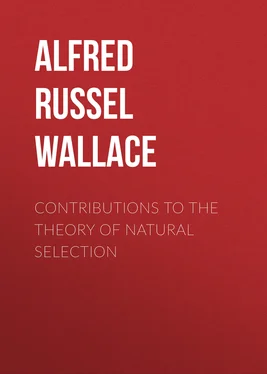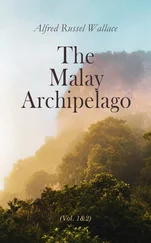Alfred Wallace - Contributions to the Theory of Natural Selection
Здесь есть возможность читать онлайн «Alfred Wallace - Contributions to the Theory of Natural Selection» — ознакомительный отрывок электронной книги совершенно бесплатно, а после прочтения отрывка купить полную версию. В некоторых случаях можно слушать аудио, скачать через торрент в формате fb2 и присутствует краткое содержание. Жанр: foreign_prose, foreign_edu, foreign_antique, на английском языке. Описание произведения, (предисловие) а так же отзывы посетителей доступны на портале библиотеки ЛибКат.
- Название:Contributions to the Theory of Natural Selection
- Автор:
- Жанр:
- Год:неизвестен
- ISBN:нет данных
- Рейтинг книги:4 / 5. Голосов: 1
-
Избранное:Добавить в избранное
- Отзывы:
-
Ваша оценка:
- 80
- 1
- 2
- 3
- 4
- 5
Contributions to the Theory of Natural Selection: краткое содержание, описание и аннотация
Предлагаем к чтению аннотацию, описание, краткое содержание или предисловие (зависит от того, что написал сам автор книги «Contributions to the Theory of Natural Selection»). Если вы не нашли необходимую информацию о книге — напишите в комментариях, мы постараемся отыскать её.
Contributions to the Theory of Natural Selection — читать онлайн ознакомительный отрывок
Ниже представлен текст книги, разбитый по страницам. Система сохранения места последней прочитанной страницы, позволяет с удобством читать онлайн бесплатно книгу «Contributions to the Theory of Natural Selection», без необходимости каждый раз заново искать на чём Вы остановились. Поставьте закладку, и сможете в любой момент перейти на страницу, на которой закончили чтение.
Интервал:
Закладка:
Rudimentary Organs
Another important series of facts, quite in accordance with, and even necessary deductions from, the law now developed, are those of rudimentary organs. That these really do exist, and in most cases have no special function in the animal oeconomy, is admitted by the first authorities in comparative anatomy. The minute limbs hidden beneath the skin in many of the snake-like lizards, the anal hooks of the boa constrictor, the complete series of jointed finger-bones in the paddle of the Manatus and whale, are a few of the most familiar instances. In botany a similar class of facts has been long recognised. Abortive stamens, rudimentary floral envelopes and undeveloped carpels, are of the most frequent occurrence. To every thoughtful naturalist the question must arise, What are these for? What have they to do with the great laws of creation? Do they not teach us something of the system of Nature? If each species has been created independently, and without any necessary relations with pre-existing species, what do these rudiments, these apparent imperfections mean? There must be a cause for them; they must be the necessary results of some great natural law. Now, if, as it has been endeavoured to be shown, the great law which has regulated the peopling of the earth with animal and vegetable life is, that every change shall be gradual; that no new creature shall be formed widely differing from anything before existing; that in this, as in everything else in Nature, there shall be gradation and harmony,—then these rudimentary organs are necessary, and are an essential part of the system of Nature. Ere the higher Vertebrata were formed, for instance, many steps were required, and many organs had to undergo modifications from the rudimental condition in which only they had as yet existed. We still see remaining an antitypal sketch of a wing adapted for flight in the scaly flapper of the penguin, and limbs first concealed beneath the skin, and then weakly protruding from it, were the necessary gradations before others should be formed fully adapted for locomotion. 3 3 The theory of Natural Selection has now taught us that these are not the steps by which limbs have been formed; and that most rudimentary organs have been produced by abortion, owing to disuse, as explained by Mr. Darwin.
Many more of these modifications should we behold, and more complete series of them, had we a view of all the forms which have ceased to live. The great gaps that exist between fishes, reptiles, birds, and mammals would then, no doubt, be softened down by intermediate groups, and the whole organic world would be seen to be an unbroken and harmonious system.
Conclusion
It has now been shown, though most briefly and imperfectly, how the law that “ Every species has come into existence coincident both in time and space with a pre-existing closely allied species ,” connects together and renders intelligible a vast number of independent and hitherto unexplained facts. The natural system of arrangement of organic beings, their geographical distribution, their geological sequence, the phænomena of representative and substituted groups in all their modifications, and the most singular peculiarities of anatomical structure, are all explained and illustrated by it, in perfect accordance with the vast mass of facts which the researches of modern naturalists have brought together, and, it is believed, not materially opposed to any of them. It also claims a superiority over previous hypotheses, on the ground that it not merely explains, but necessitates what exists. Granted the law, and many of the most important facts in Nature could not have been otherwise, but are almost as necessary deductions from it, as are the elliptic orbits of the planets from the law of gravitation.
II.
ON THE TENDENCY OF VARIETIES TO DEPART INDEFINITELY FROM THE ORIGINAL TYPE. 4 4 Written at Ternate, February, 1858; and published in the Journal of the Proceedings of the Linnæan Society for August, 1858.
Instability of Varieties supposed to prove the permanent distinctness of Species
One of the strongest arguments which have been adduced to prove the original and permanent distinctness of species is, that varieties produced in a state of domesticity are more or less unstable, and often have a tendency, if left to themselves, to return to the normal form of the parent species; and this instability is considered to be a distinctive peculiarity of all varieties, even of those occurring among wild animals in a state of nature, and to constitute a provision for preserving unchanged the originally created distinct species.
In the absence or scarcity of facts and observations as to varieties occurring among wild animals, this argument has had great weight with naturalists, and has led to a very general and somewhat prejudiced belief in the stability of species. Equally general, however, is the belief in what are called “permanent or true varieties,”—races of animals which continually propagate their like, but which differ so slightly (although constantly) from some other race, that the one is considered to be a variety of the other. Which is the variety and which the original species , there is generally no means of determining, except in those rare cases in which the one race has been known to produce an offspring unlike itself and resembling the other. This, however, would seem quite incompatible with the “permanent invariability of species,” but the difficulty is overcome by assuming that such varieties have strict limits, and can never again vary further from the original type, although they may return to it, which, from the analogy of the domesticated animals, is considered to be highly probable, if not certainly proved.
It will be observed that this argument rests entirely on the assumption, that varieties occurring in a state of nature are in all respects analogous to or even identical with those of domestic animals, and are governed by the same laws as regards their permanence or further variation. But it is the object of the present paper to show that this assumption is altogether false, that there is a general principle in nature which will cause many varieties to survive the parent species, and to give rise to successive variations departing further and further from the original type; and which also produces, in domesticated animals, the tendency of varieties to return to the parent form.
The Struggle for Existence
The life of wild animals is a struggle for existence. The full exertion of all their faculties and all their energies is required to preserve their own existence and provide for that of their infant offspring. The possibility of procuring food during the least favourable seasons, and of escaping the attacks of their most dangerous enemies, are the primary conditions which determine the existence both of individuals and of entire species. These conditions will also determine the population of a species; and by a careful consideration of all the circumstances we may be enabled to comprehend, and in some degree to explain, what at first sight appears so inexplicable—the excessive abundance of some species, while others closely allied to them are very rare.
The Law of Population of Species
The general proportion that must obtain between certain groups of animals is readily seen. Large animals cannot be so abundant as small ones; the carnivora must be less numerous than the herbivora; eagles and lions can never be so plentiful as pigeons and antelopes; and the wild asses of the Tartarian deserts cannot equal in numbers the horses of the more luxuriant prairies and pampas of America. The greater or less fecundity of an animal is often considered to be one of the chief causes of its abundance or scarcity; but a consideration of the facts will show us that it really has little or nothing to do with the matter. Even the least prolific of animals would increase rapidly if unchecked, whereas it is evident that the animal population of the globe must be stationary, or perhaps, through the influence of man, decreasing. Fluctuations there may be; but permanent increase, except in restricted localities, is almost impossible. For example, our own observation must convince us that birds do not go on increasing every year in a geometrical ratio, as they would do, were there not some powerful check to their natural increase. Very few birds produce less than two young ones each year, while many have six, eight, or ten; four will certainly be below the average; and if we suppose that each pair produce young only four times in their life, that will also be below the average, supposing them not to die either by violence or want of food. Yet at this rate how tremendous would be the increase in a few years from a single pair! A simple calculation will show that in fifteen years each pair of birds would have increased to nearly ten millions! 5 5 This is under estimated. The number would really amount to more than two thousand millions!
whereas we have no reason to believe that the number of the birds of any country increases at all in fifteen or in one hundred and fifty years. With such powers of increase the population must have reached its limits, and have become stationary, in a very few years after the origin of each species. It is evident, therefore, that each year an immense number of birds must perish—as many in fact as are born; and as on the lowest calculation the progeny are each year twice as numerous as their parents, it follows that, whatever be the average number of individuals existing in any given country, twice that number must perish annually ,—a striking result, but one which seems at least highly probable, and is perhaps under rather than over the truth. It would therefore appear that, as far as the continuance of the species and the keeping up the average number of individuals are concerned, large broods are superfluous. On the average all above one become food for hawks and kites, wild cats or weasels, or perish of cold and hunger as winter comes on. This is strikingly proved by the case of particular species; for we find that their abundance in individuals bears no relation whatever to their fertility in producing offspring.
Интервал:
Закладка:
Похожие книги на «Contributions to the Theory of Natural Selection»
Представляем Вашему вниманию похожие книги на «Contributions to the Theory of Natural Selection» списком для выбора. Мы отобрали схожую по названию и смыслу литературу в надежде предоставить читателям больше вариантов отыскать новые, интересные, ещё непрочитанные произведения.
Обсуждение, отзывы о книге «Contributions to the Theory of Natural Selection» и просто собственные мнения читателей. Оставьте ваши комментарии, напишите, что Вы думаете о произведении, его смысле или главных героях. Укажите что конкретно понравилось, а что нет, и почему Вы так считаете.












